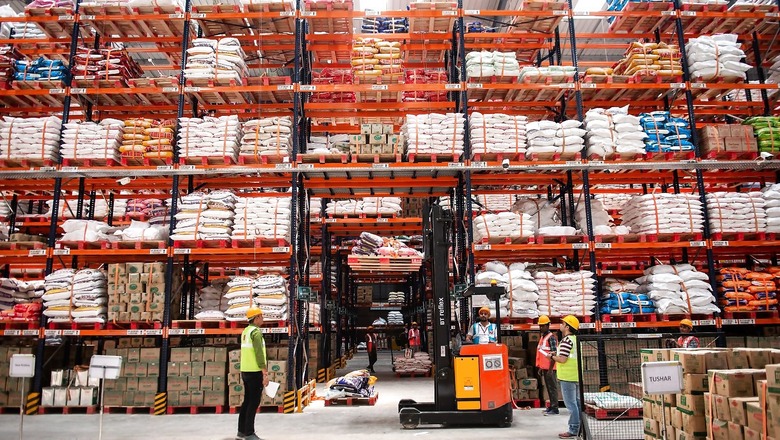
views
Prime Minister Narendra Modi, on the occasion of his 72nd birthday, gifted to the country the National Logistics Policy (NLP), which is aimed at promoting seamless movement of goods and enhancing the competitiveness of the industry. The policy is expected to focus on areas such as process re-engineering, digitisation, and multi-modal transport. The move assumes significance as high logistics cost impacts the competitiveness of domestic goods in the international market.
“The need for a national logistics policy was felt since the logistics cost in India is high as compared to other developed economies. It is imperative to reduce the logistics cost in India for improving the competitiveness of Indian goods both in domestic as well as export markets,” an official statement said on Friday.
Reduced logistics cost improves efficiency cutting across various sectors of the economy, encouraging value addition and enterprise. It said that the policy is an effort to address issues of high cost and inefficiency by laying down an overarching interdisciplinary, cross-sectoral and multi-jurisdictional framework for the development of the entire logistics ecosystem.
News18 breaks down the terminology for you and explains all about the policy:
What is NLP?
First introduced in 2020 during Finance Minister Nirmala Sitharaman’s Budget speech, the policy, according to the government, will bring in an integrated and tech-enabled approach to logistics operations to bridge the efficiency gap. On September 13, Commerce and Industry Minister Piyush Goyal said the government has stressed the need to reduce logistics costs in the country from the current levels of 13-14 per cent of GDP.
A comprehensive action plan is proposed under the policy, with major features including integrated digital logistics systems; unified logistics interface platform; ease of logistics; and standardisation of physical assets and benchmarking service quality standards, state engagement, human resource development and capacity building, export-import logistics, sectoral plans for efficient logistics, and facilitation of the development of logistics parks.
Why the need for a policy?
The logistics cost in India is high as against 9-10 per cent in the US and Europe and 11 per cent in Japan. There is no single department which manages the sector as it is currently being managed by many ministries, including road transport, shipping, railways, civil aviation, posts and commerce and industry, and finance.
According to the Commerce Ministry, the sector is complex with more than 20 government agencies, 40 PGAs (Partner Government Agencies), 37 export promotion councils, 500 certifications, over 10,000 commodities, and USD 160 billion market size. It also involves 200 shipping agencies, 36 logistics services, 129 ICDs (Inland Container Depots), 168 CFSs (Container Freight Stations), 50 IT ecosystems, banks and insurance agencies.
The sector provides livelihood to more than 22 million people and improving it will facilitate 10 per cent decrease in indirect logistics cost leading to the growth of 5 to 8 per cent in exports, the ministry had stated. As per estimates, the worth of Indian logistics market is over $200 billion.
What are the focus areas?
According to several reports, PM Modi is expected to touch upon four main steps:
1. Integration of Digital System (IDS): This system will look forward to integrating 30 different systems of seven different departments, which are road transport, railway, customs, aviation, foreign trade, and commerce ministries. The digital data from these departments will be integrated under IDS. This will directly affect shorter cargo movement in a positive way.
2. Unified Logistics Interface Platform (ULIP): This system will monitor smooth cargo movement.
3. Ease of Logistics (ELOG):
Under this, the new policy will simplify the rules, which is expected to simplify basic business.
4. System Improvement Group (SIG):
This system will be used to monitor all logistics-related projects regularly and will facilitate the removal of any hurdle.
An empowered group of secretaries (EGoS), constituted under the PM Gati Shakti, would monitor and review the implementation of the policy. A service improvement group would also be constituted for resolution of issues faced by the users.
What does the industry expect?
Assocham’s immediate past president Vineet Agarwal, as quoted by Moneycontrol, expects the policy to address prevailing concerns in India’s logistics sector from an international lens. He added that a comprehensive national policy for the logistics sector is critical as it will help the country understand how it can reach its economic goals.
Arindam Guha, leader and partner for government and public services at Deloitte India, said the NLP will aim to increase the movement of cargo through the Indian Railways in a combination of additional infrastructure investments and formalising and mobilising the supporting ecosystem and also enabling single-window approvals, Moneycontrol reported.
Ravi Jakhar, chief strategy officer at Allcargo Logistics, said the focus on building integrated infrastructure to enhance connectivity will eventually reduce the cost of carrying cargo and increase operational efficiency.
(With PTI inputs)
Read all the Latest Explainers News and Breaking News here




















Comments
0 comment